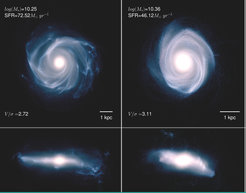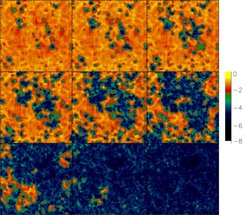Benedetta Ciardi's research interests
Early structure formation and feedback effects

The first structures to appear in the universe form the building blocks of present day galaxies and host the first stars, which initiate a complex interaction among different physical processes and deeply affect subsequent structure formation and evolution through feedback effects (Maio et al. 2007; Maio et al. 2009; Maio et al. 2010; Maio, Koopmans & Ciardi 2011; Maio et al. 2011; Maio, Borgani, Ciardi & Petkova 2019; Maio, Peroux & Ciardi 2022; Bhagwat et al. 2024; Casavecchia et al. 2024). The latter can be broadly classified as (i) chemical (associated to the metal enrichment which impacts the gas cooling), (ii) mechanical (through winds and supernovae explosions), and (iii) radiative (associated to ionization and heating of the gas from UV and X-ray photons). Despite the fundamental role played in shaping the universe we observe today, feedback effects are still poorly understood and are the subject of a continuous investigation (Ciardi & Ferrara 2005).
Reionization of the IGM

The most relevant among the radiative feedback effects is the reionization of the IGM (Ciardi et al. 2000; Ciardi, Stoehr & White 2003; Ciardi, Ferrara & White 2003; Ciardi et al. 2006; Ciardi et al. 2012; Jeeson-Daniel, Ciardi & Graziani 2014; Leite et al. 2017; Hassan et al. 2018; Eide et al. 2018; Hattab et al. 2019; Bush et al. 2020, Eide et al. 2020; Ma et al. 2022). The radiation emitted by the first objects escapes from its production sites into the IGM (Kostyuk et al. 2023; Kostyuk, Ciardi & Ferrara 2024) and starts to reionize the surrounding gas. This epoch, when light returned after the so-called `Dark Ages', marks the beginning of the reionization process. While observations of absorption features in the spectra of high-z quasars show near complete absorption at epochs of 1 billion years after the Big Bang and have been interpreted as mapping the tail end of cosmic reionization, the analysis of the maps of temperature anisotropies in the cosmic microwave background (CMB) radiation from the WMAP and PLANCK satellites suggests that reionization must have begun at much earlier times, and so must have had a complex history. A theoretical modeling of the process is paramount to the understanding of the present day universe due to its impact on structure formation.
Radiative transfer

While semi-analytic approaches are a useful tool for a parameter exploration in reionization studies, a more correct modeling of the reionization process requires following the full radiative transfer of ionizing photons. CRASH (Ciardi et al. 2001; Maselli, Ferrara & Ciardi 2003; Iliev et al. 2006; Maselli, Ciardi & Kanekar 2009; Pierleoni, Maselli & Ciardi 2009; Partl et al. 2011; Graziani, Maselli & Ciardi 2013, Hariharan et al. 2017, Graziani, Ciardi & Glatzle 2018, Glatzle, Ciardi & Graziani 2019; Glatzle, Graziani & Ciardi 2022) is a 3D Monte-Carlo radiative transfer code which follows the propagation of UV and X-ray photons emitted by an arbitrary number of point sources through an inhomogeneous gas distribution. It calculates self-consistently the evolution of hydrogen, helium, gas temperature and some metal species.
Observational probes

A theoretical modeling of the high-z universe should be guided by observations. For this reason, it is important to use the outcome of such modeling to compare to observational data, when available, or to propose observational strategies for planned/future facilities. Among possible probes of the high-z universe we can mention e.g. gravitational wave emission (Schneider et al. 2000), infrared molecular line radiation from the first stars (Ciardi & Ferrara 2001), the detection of gamma-ray bursts through the intergalactic gas (Ciardi & Loeb 2000; Inoue, Omukai & Ciardi 2007; Campisi et al. 2011; Salvaterra et al. 2013; Ma et al. 2015; Ciardi et al. 2015; Ma, Maio, Ciardi & Salvaterra 201; Amati et al. 2018; Tanvir et al. 2021) the imprint that reionization should leave on the temperature anisotropies in the CMB (Bruscoli et al. 2000; Salvaterra et al. 2005), high-z Ly-α emitters and emission (Kurk et al. 2004; Jeeson-Daniel et al. 2012; Kakiichi, Dijkstra, Ciardi & Graziani 2016; Chung et al. 2019) and damped Ly-α absorbers (Ma, Maio, Ciardi & Salvaterra 2017), detections of metals and dust in high-z galaxies (Mancini et al. 2015; Graziani et al. 2019), investigations of high-z radio galaxies and blazars (Ghisellini et al. 2015; Wu et al. 2017; Napier et al. 2020; Hodges-Kluck et al. 2021; Kappes et al. 2022).
21cm line from neutral hydrogen

Although since the late 1950s it has been recognized that neutral hydrogen in the IGM may be directly detectable in emission or absorption against the CMB radiation at the frequency corresponding to the redshifted neutral hydrogen 21 cm line providing a direct probe of the era of cosmological reionization, only now radio interferometers such as LOFAR, MWA and HERA are delivering the first data. At present we only have available observations of the latest stages of the process and of the global amount of electrons produced during reionization, but we are mostly lacking information on the reionization history and its sources. The 21cm line from neutral hydrogen in the IGM (and the equivalent 3.5cm line from singly ionized helium, Khullar et al. 2020) would provide invaluable information on the distribution and evolution of HI and would allow, for the first time, to map the temporal evolution of the reionization process (Ciardi & Madau 2003; Di Matteo, Ciardi & Salvaterra 2004; Salvaterra et al. 2005; Valdes et al. 2006; Ciardi & Salvaterra 2007, Maio, Ciardi & Koopmans; Ciardi et al. 2013; Ciardi et al. 2015; Kakiichi et al. 2017; Zackrisson et al. 2020; Ma et al. 2020; Ghara et al. 2021; Ma et al. 2021; Ma et al. 2023; Acharya, Garaldi & Ciardi 2024). An increasing attention is being devoted to using the 21cm line in combination with observations in different frequency bands. This would likely (i) help to reduce systematic effects, (ii) confirm the cosmological origin of the 21cm signal, and (iii) provide additional insight into the properties of high-z sources. Investigations have been made on cross-correlating the 21cm line with Ly-α emitters (Wiersma et al. 2013; Vrbanec et al. 2016; Vrbanec et al. 2020), CMB radiation (Ma et al. 2018), X-ray background (Ma, Ciardi, Eide & Helgason 2018), metal emission and absorption lines (Moriwaki, Yoshida, Eide & Ciardi 2019; Bhagwat, Ciardi, Zackrisson & Schaye 2022).
I am a core member of the LOFAR Epoch of Reionization Key Science Project (e.g. Jelic et al. 2008; Harker et al. 2010; Zaroubi et al. 2012; Ciardi et al. 2013; Jensen et al. 2013; Yatawatta et al. 2013; Wiersma et al. 2013; Patil et al. 2014; Ciardi et al. 2015; Vedantham et al. 2015, Vrbanec et al. 2016; Patil et al. 2017; Gehlot et al. 2019; Mertens et al. 2020; Ghara et al. 2020; Mevius et al. 2022; Gan et al. 2023), and MPA has also contributed to the LOFAR project building one of the international stations.




